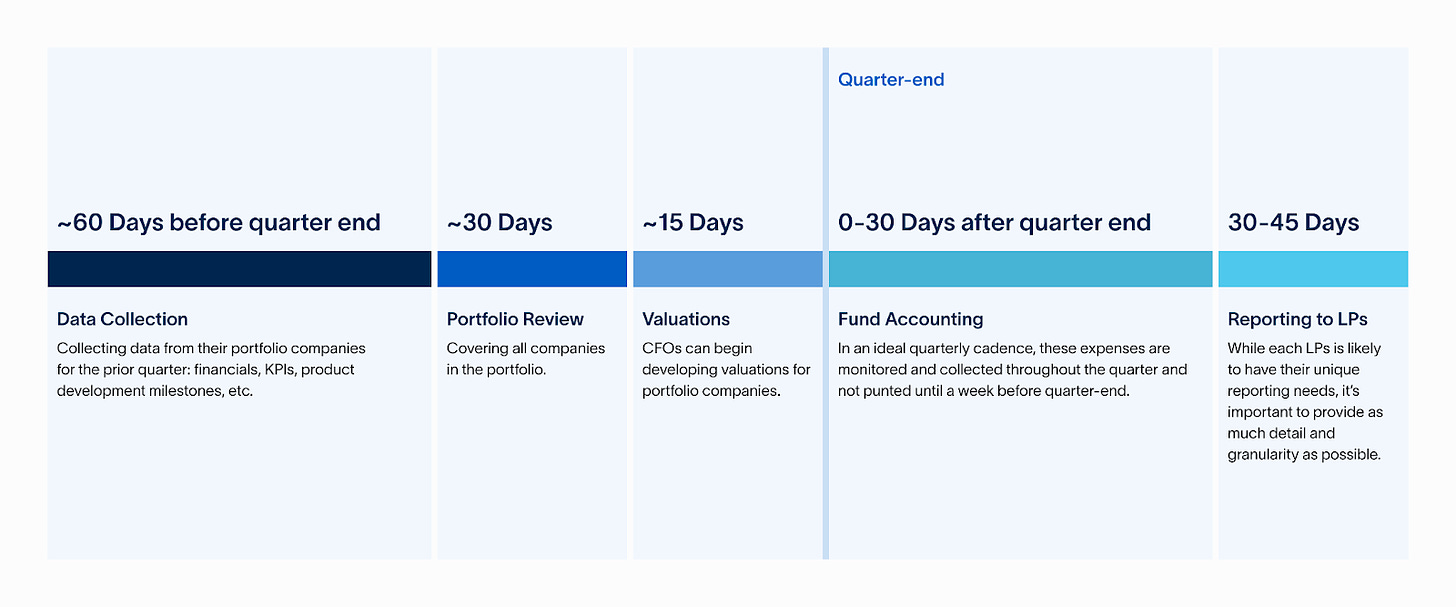In The Modern Venture Capital CFO Part 1, we highlighted how venture capital CFOs are perfectly positioned to lead the evolution of today’s VC firms, and we discussed the importance of data transparency to the industry.
Since then, the public markets have taken a nosedive, and the VC industry is in limbo. Teams are scrambling to understand how LPs and entrepreneurs — their key stakeholders — will behave in the months and years to come. Is this the dot-com crash, March of 2020, or something else entirely?
The VC CFO role is more crucial now than ever in this downturn. In Part 2 of this series, we’ll dive deeper into how VC firms can survive, and ultimately thrive, in the current market. Strong stakeholder communication and excellent portfolio management are necessary to make it to the other side.
The bar has gone up for the industry overnight, and we’re here to share how firms need to plan for the future. This starts with the rituals and tools that firms use to collect and utilize their critical data.
Today’s VC stakeholders are data hungry
All of a sudden, VCs are now subjected to greater LP scrutiny around their valuations and more rigorous reporting needs. Faced with difficult decisions and market uncertainty, deal teams are also increasingly demanding data to inform investment decisions and portfolio-company analysis.
To meet these demands and create greater transparency across the portfolio, VC CFOs need to rethink their data collection and reporting practices. Many firms still handle their critical business data by hand, copying and pasting data points in spreadsheets. In this environment, VC firms need to immediately focus on scalability of their data collection and visibility through software. Better data leads to a stronger narrative around a firm’s strategy and more satisfied LPs. It also empowers internal deal teams to make better investment decisions as well as opportunities to provide critical portfolio support — like identifying and helping a company that’s burning too much cash — which positively impact fund performance.
Every quarter is an opportunity to structure, aggregate, and generate actionable information on the performance of the firm and its portfolio. To professionalize this process and stay ahead of never-ending, overlapping deadlines, CFOs must develop systematic quarterly timelines that begin with portfolio company metrics and end with LP reporting and structured, standardized data designed to inform decision-making.
When a CFO perfects their quarterly timeline, it runs in the background like a well-oiled machine delivering data and insights to all relevant stakeholders.
The venture capital CFO timeline
Every VC firm operates on a timeline that dictates their approach and timing for data collection, portfolio review, valuations, closing the financial books, and LP reporting. Many of these steps take place across disparate tools and platforms in a VC’s tech stack. Bringing them all together into one centralized workflow is part of Standard Metrics’ mission.
This is a timeline developed by early Standard Metrics clients. A group of CFOs refined an ideal timeline for the quarterly cadence of VC finance and have since optimized it with the help of Standard Metrics’ tools.
Data collection: 60 days before quarter-end
Understanding the health of a venture capital portfolio starts with data collection. At approximately 60 days before the upcoming quarter-end, CFOs should be collecting data from their portfolio companies for the prior quarter: financials, key performance indicators (KPIs), product development milestones, et cetera.
Transparency is especially important at this step of the process. It’s vital that VCs communicate clearly to their portfolio companies the rationale for requesting this data. In addition to being financial backers, VCs are also strategic partners. Without full clarity into a company’s data, investors cannot provide the right advice and guidance, which is why they need to communicate the importance of transparency with their portfolio and mitigate any fear or discomfort that companies may have when sharing underwhelming data.
Portfolio review: 30 days before quarter-end
At this point, the firm should have collected all the data it needs and can proceed to a full portfolio review. This review, covering all active companies in the portfolio, should be much more thorough than the type of review that happens during a typical Monday morning meeting. Presently, the industry standard is to conduct full portfolio reviews on an annual or semi-annual basis. With the amount of data firms need to collect today, a full portfolio review should be a quarterly practice.
Our point of view is that quarterly company data is the bare minimum, and VC CFOs should endeavor to collect monthly data through automated tools. In fact, with the right systems and processes, investors can review the most relevant companies even weekly without sacrificing efficiency.
Valuations: 5 days before quarter-end
Using the financials and cap table data gathered during the data collection period, CFOs can begin developing valuations for portfolio companies.
With the recent volatility in the public markets, in addition to the increased focus on fair value and reporting regulations, blanket applications of last round valuations are not sufficient anymore. A consistently applied, auditable valuation policy, either developed in-house or with support from valuation firms such as Derivatas, is key for regulatory compliance and trusting LP relationships.
Fund accounting: 0-30 days after quarter-end
Portfolio company metrics aren’t the only important data points. In addition to calculating valuations for the portfolio, CFOs must track cash flows and calculate fund performance. In an ideal quarterly cadence, cash flows are monitored and collected throughout the quarter and not punted until a week before quarter-end, and typically managed either by fund administrators or in-house back office teams with the use of fund accounting systems.
With approved valuations and fund accounting complete, CFOs can move on to closing the financials for the quarter.
The final step in the quarterly cadence is to report finalized data to LPs and update internal stakeholders. While each LP may have unique reporting needs, creating a detailed, standardized report with granular data may solve for all unique requests while also providing LPs with additional information and an opportunity to make their own data ingestion easier. LP relationships are key to long-term success, and they are built on trust and transparency. Going the extra mile today can pay outsized dividends in turbulent times.
Preparing LP reporting materials can take substantial internal resources when done by hand; using software to deliver data-rich and compelling LP materials will become the industry norm.
The key is transparency
When you deliver transparent and timely data to your LPs, you’re not only providing an update on the portfolio and fund performance, but you’re also cultivating closer relationships with your important partners. When your internal team has access to your latest portfolio data, they can make informed decisions around how they spend time supporting portfolio companies, and they have better tools to evaluate new and follow-on investments.
To be “in the game” in today’s choppy market means having full access and control of your firm’s data. Firms that master their data will be a step ahead of their competitors both in how they make decisions at the portfolio company-level and how they service LP needs.
Most firms that do not aggressively pivot to data-centric, streamlined, and software-driven operations are NGMI — not going to make it.
Automate your portfolio reporting
Find out how you can:
- Collect a higher volume of accurate data
- Analyze a robust, auditable data set
- Deliver insights that drive fund performance



